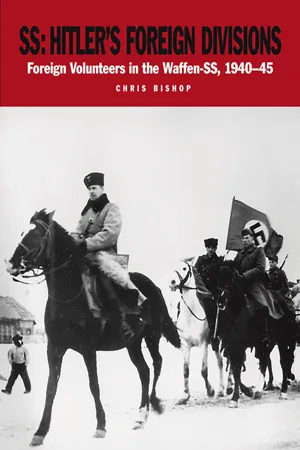
- English
- ePUB (mobile friendly)
- Available on iOS & Android
About this book
The divisions of the Waffen-SS were the elite of Hitler's armies in World War II, but the most fanatical of them were not even German. The book offers a comprehensive examination of every foreign Waffen-SS formation, including well-known divisions such as Wiking, Nord, and Prinz Eugen, notoriously brutal units such as the Kaminski Brigade and the British-recruited Britisches Freikorps. Each unit's history, structure and combat record is described in detail.Despite their non-Germanic background, the Norwegians, Dutch, Danes, Belgians, Latvians, Estonians, Cossacks, Ukrainians and other nationalities – often motivated by an extreme anti-Communist zeal – fought hard on the Eastern Front for the Nazi cause, even when their position was hopeless. Often treated badly by their German commanders, the foreign SS units were not all excellent combat formations, however. Some, like the British and Indian volunteers, were used for propaganda purposes only, while others like the notorious Dirlewanger Brigade, who helped brutally surpress the Warsaw Rising in 1944, were nothing more than murderous criminals in uniform. Other divisions formed in the final months of the war never reached functional strength, and were disbanded before they saw action. SS: Hitler's Foreign Divisions is a definitive history of the 350, 000 foreigners who fought for Hitler and Germany in World War II.
Frequently asked questions
- Essential is ideal for learners and professionals who enjoy exploring a wide range of subjects. Access the Essential Library with 800,000+ trusted titles and best-sellers across business, personal growth, and the humanities. Includes unlimited reading time and Standard Read Aloud voice.
- Complete: Perfect for advanced learners and researchers needing full, unrestricted access. Unlock 1.4M+ books across hundreds of subjects, including academic and specialized titles. The Complete Plan also includes advanced features like Premium Read Aloud and Research Assistant.
Please note we cannot support devices running on iOS 13 and Android 7 or earlier. Learn more about using the app.
Information
From its earliest days, the SS was a volunteer organization which saw itself as an elite within the Nazi state. Troops of the first SS divisions were exceptionally fit, and the first foreign recruits were expected to be of the same standard. However, by the middle of the war manpower shortages meant that to fill out newly forming units like the Prinz Eugen and the Florian Geyer divisions the SS had to accept recruits of a considerably lower standard.
Table of contents
- Cover
- Title
- Copyright
- Contents
- Introduction
- Western Europe
- Eastern Europe
- The Foreign SS Divisions
- The Foreign SS Brigades
- Foreign Waffen-SS Divisions, Knight's Crosses Awarded
- Bibliography